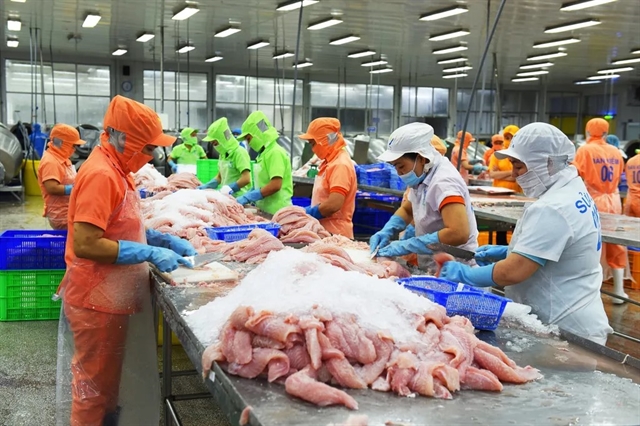 Economy
Economy

 |
| A pangasius processing line for export at Hùng Cá JSC. — VNA/VNS Photo |
HÀ NỘI — Vietnamese pangasius has made a big splash across global markets, yet it remains a rare sight on local dinner tables. Despite its billion-dollar export success, only five to seven per cent of pangasius production is consumed domestically, presenting a puzzling paradox for the industry.
According to data from the Department of Customs, pangasius exports reached over US$1.1 billion by mid-July this year, marking an 11 per cent increase compared to the same period last year. Some markets demonstrated remarkable growth: Brazil’s imports surged by 73 per cent, Malaysia’s by 33 per cent, Thailand’s by 32 per cent, and the United States’ by 12 per cent, signalling a rebound in demand in key regions.
Yet, the journey is far from smooth. The Vietnam Association of Seafood Exporters and Producers (VASEP) reports that exports to Colombia dropped by 10 per cent, while Germany and Saudi Arabia saw declines of nearly 20 per cent and 15.1 per cent respectively.
Further compounding these challenges are global economic pressures such as trade tensions, inflation, currency volatility, and potential new tariffs from the US, all of which threaten to usher in a period of uncertainty for the pangasius sector.
Domestically, the market remains modest. Most pangasius is farmed and processed for export, with local consumers typically purchasing whole or pre-filleted fish presented in basic packaging, often lacking brand recognition. VASEP attributes this to ingrained consumer habits favouring traditional fish like snakehead, carp, and climbing perch over farmed pangasius.
Additionally, the domestic selling price is generally 30 to 40 per cent lower than export prices, rendering the local market less attractive for producers and distributors. However, experiences from neighbouring countries demonstrate the potential of a thriving domestic market.
In Thailand, where tilapia farming is well-established, around 60 per cent of the production is consumed locally, supported by government initiatives that supply fish to schools, hospitals, the military, and public institutions.
India offers another instructive example. Despite being a major global exporter, its enormous population of 1.4 billion relies heavily on freshwater fish as a primary protein source. This domestic demand helps maintain stable production levels even when export markets fluctuate.
With a population nearing 100 million, rising living standards and growing demand for clean, convenient food, Vietnam has the ingredients to cultivate a strong internal market for pangasius. Overcoming existing obstacles—ranging from consumer perceptions and cooking habits to distribution networks, packaging innovation and brand communication—will be crucial.
Some Vietnamese companies have begun diversifying into processed pangasius products such as fish paste, fish balls and packaged fish noodles, targeting younger consumers, students, workers and institutional kitchens. Yet, VASEP stresses that for the domestic market to evolve into a true 'lifeline,' more decisive action is needed.
Programmes that introduce pangasius into school meal plans, incentives to boost seafood consumption, and nationwide media campaigns could transform the sector’s domestic outlook. The unpredictability of export markets means that over-reliance on foreign sales leaves the industry vulnerable.
“The domestic market is not the only solution, but it is an indispensable part of a sustainable development strategy for the pangasius industry,” VASEP stated. “It is time for Vietnam to treat the domestic market as a real market, not just a short-term solution when exports are difficult, but a long-term stronghold to build resilience for the entire pangasius value chain.”
In a sector buffeted by international trade winds, strengthening the home market could secure the future for producers, protect farmers’ livelihoods, and stabilise jobs, making the humble pangasius a national staple rather than just an export commodity. — VNS




